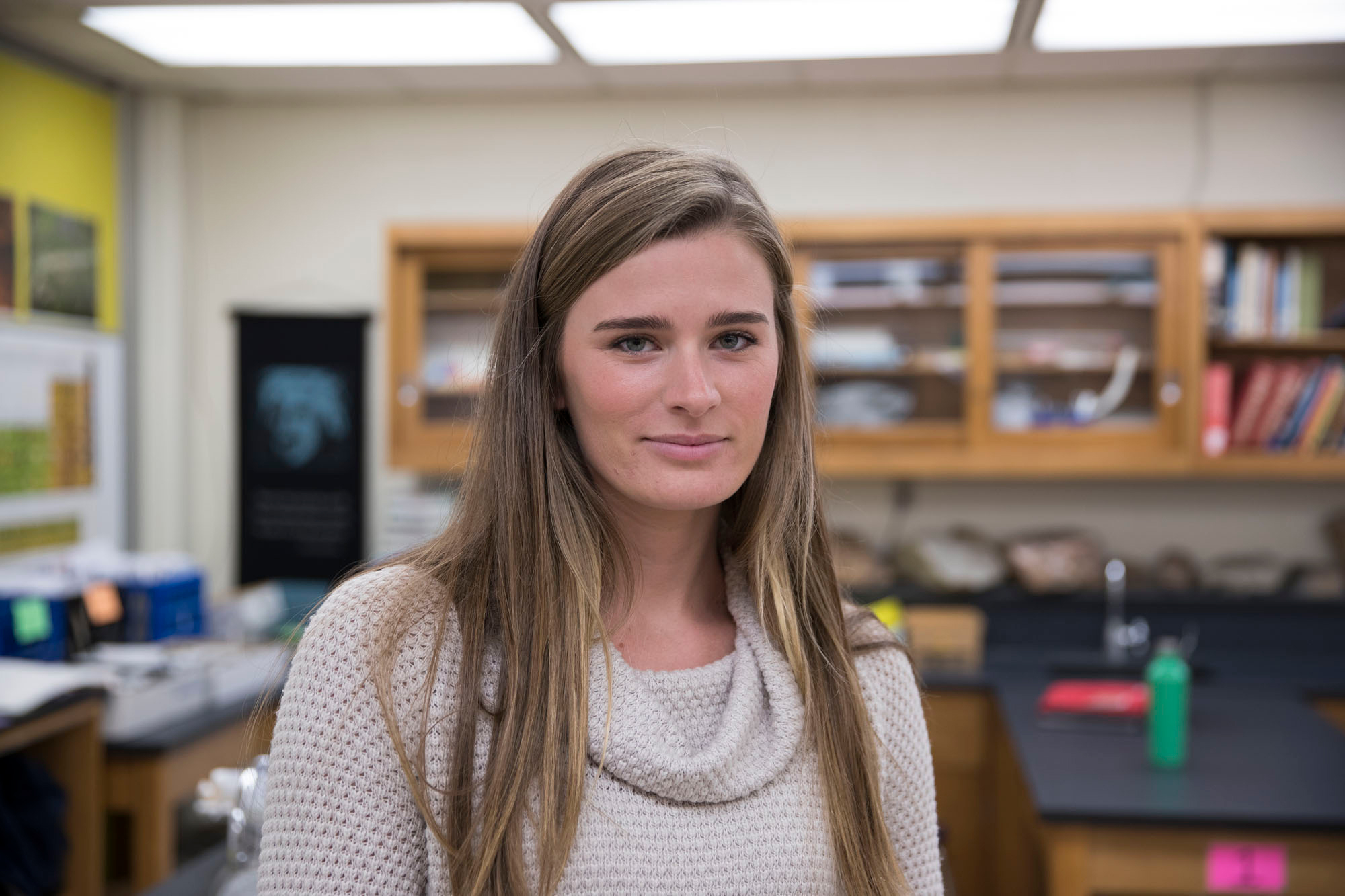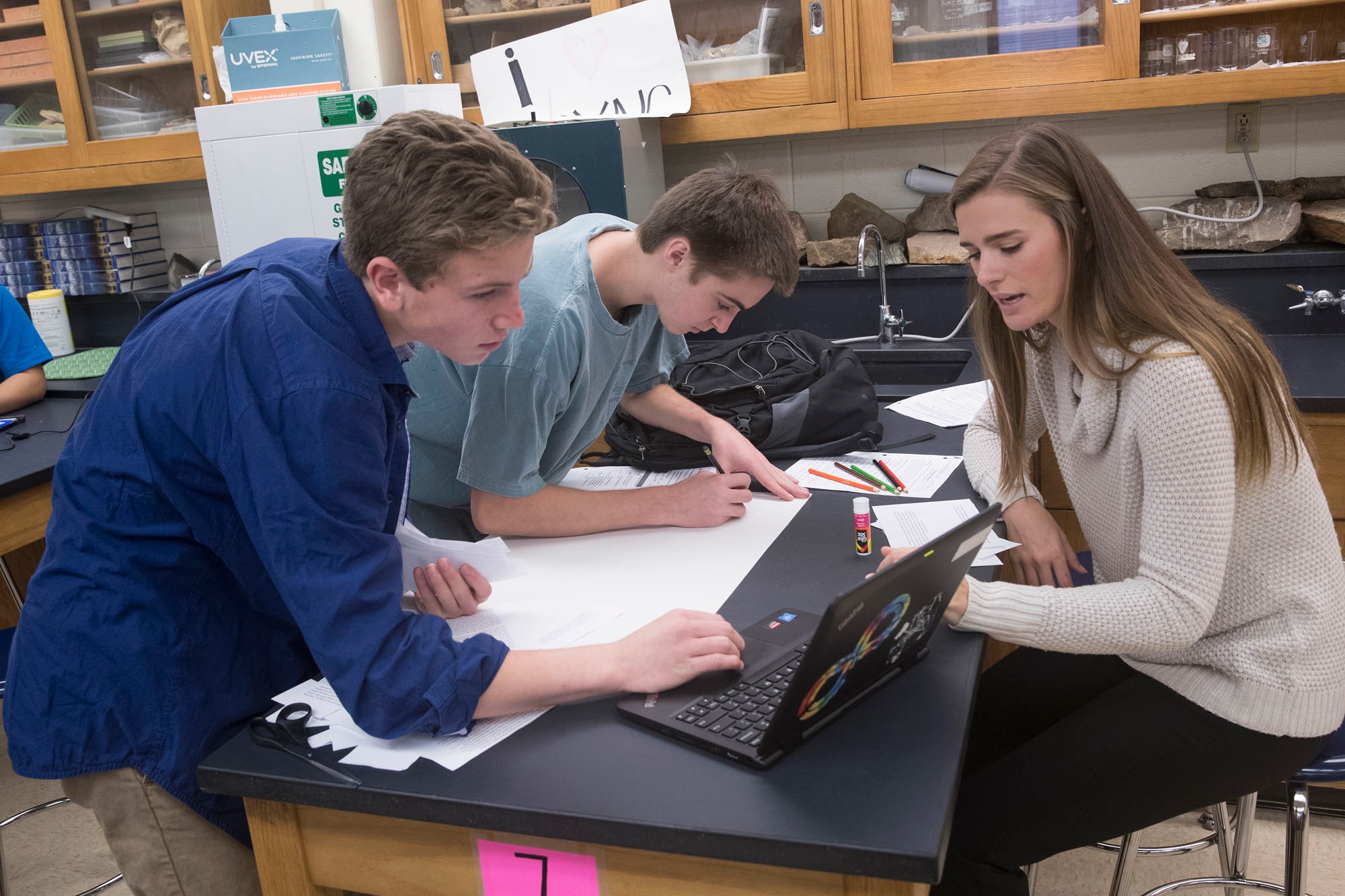To prepare children for the future, today’s science classes must go way beyond textbooks and simple frog dissections. At one high school in Virginia, a student-teacher from the University of Virginia’s Curry School of Education has created an innovative project that has students learning both cell biology concepts and engineering design skills at the same time.
A deadly, contagious disease has infected the population – and it’s spreading. Fast. How would you design a quarantine facility to keep it contained?
That’s the challenge that biology students at Western Albemarle High School faced this year, with a few important distinctions: in this case, the “deadly disease” was a live (but perfectly safe) organism called slime mold, the “healthy population” was a few dry oats, and the quarantine had to fit in a petri dish.
Slime mold is a unique single-celled organism that has the ability to communicate and behave like a colony when food, like oats, is in short supply. Often resembling a fungus, slime mold can form efficient, highway-like networks – even solve mazes.
Biology students at Western Albemarle, located in Albemarle County, have studied slime mold for years, but this year’s project was different. Each student was charged with sketching a quarantine design that would keep the “virus” contained. Then, in small teams, they brainstormed possible solutions, considered the constraints of their materials and budget, and created prototypes using materials like Legos, aluminum foil, pipe cleaners and straws. They tested their designs, re-designed and re-tested in search of the most effective quarantine facility.
Throughout the process, the students learned core biology concepts like cell anatomy – but that’s not what made the project successful. Taylor Avery, the student-teacher, was inspired to create the project after learning about an instructional method called engineering design-integrated science in her Curry School classes.

Taylor Avery works with tenth grade students at Western Albemarle High School.
By designing their own quarantines, Avery’s students weren’t just learning biology. They were also practicing engineering design: the hands-on method that engineers use to design solutions to real problems.
What is Engineering Design, and Why Does It Matter?
Avery first learned about engineering design from her Curry School professor Frackson Mumba. “Engineering is solving problems to improve human life,” Mumba explained. “Engineering has a process that engineers use to find solutions to those problems. And that process itself is called engineering design.”
Where scientists use the scientific method to observe the natural world, engineers use engineering design to improve it – by creating new, innovative solutions to human problems. Biomedical engineers, for example, create artificial organs, and mechanical engineers design air conditioning systems to keep your house at a perfect temperature.
Mumba said you don’t have to be an engineer to do engineering design. The problem-solving process can be applied to any number of subjects and it has a multitude of benefits for students.
In 2012, the National Research Council published the New Framework for K-12 science education that led to the Next-Generation Science Standards. Both reform documents require teachers to integrate engineering design into K-12 classrooms, kicking off a nationwide movement to merge engineering and science education.
By working through the engineering design process in class, students are active and engaged in the lesson, Mumba added.
“They learn science content better through hands-on research, planning, creating and testing – constantly re-evaluating and asking questions. Is the design working? If not, how do you make it work,” Mumba said. “If so, how do you make it work even better?”
Another plus: Instead of working through a prescribed lab, students are given a design challenge, which introduces a motivating element of competition. It’s also creative. Science and engineering aren’t always considered to be creative fields, but that’s exactly why the process is so valuable for students.
“Successful scientists are creative,” said Carly Tacy, Avery’s mentor teacher at Western Albemarle. “Whether they’re into engineering or not, they have to think outside the box to find different ways to look at data or set up experiments. It’s a constant challenge to figure out new ways to get more understanding, more information.
“This [project] gave our students an opportunity to use that creativity.”
Learning the engineering design process early also provides a new pathway to a career in engineering. While many school districts in the country have started adding engineering classes, they’re often available only to more advanced students and only in wealthier schools with more resources. Projects like Avery’s slime mold challenge introduce engineering design to K-12 students through their regular curriculum, making it much easier to implement.
A Training Ground for Design Engineering-Integrated Science
Together with a team of professors from both the Curry School and UVA’s School of Engineering and Applied Science, Mumba started teaching engineering design to his students as soon as he joined the Curry faculty in 2013. According to Mumba, his job is to prepare science teachers not only for today’s classrooms, but for the future of science education – in Virginia and in the rest of the country, too.
In 2014, the National Science Foundation awarded Mumba a five-year, multi-million dollar grant that will ultimately fund 50 education students with scholarships from the Robert Noyce Teacher Scholarship Program. A core component of the scholarship is learning how to teach engineering design-integrated science. Three years later, Curry has designated 37 Noyce Scholars, including Avery. The program aims to help STEM majors and professionals become K-12 teachers, with the goal of increasing the number of knowledgeable and effective STEM teachers in high-need school districts. For every year of funding, Noyce scholars commit to teach for two years in a high-need district.
For Avery, this was a perfect fit. She realized that she wanted to be a science teacher while working on community outreach projects as a fisheries biologist in South Carolina.
“During the offseason, we did a lot of outreach and education, and I think that’s what sparked my interest in teaching,” she said. “We would host school groups and take them out on boats in the harbor, and there would be kids who lived five miles away who had never seen the water before. Seeing that wonder in their faces is what I’m hoping to do with my students now.”
When she first learned about engineering design-integrated science, she was immediately intrigued. “I had an idea of what engineering entailed,” she said. “But I never realized how accessible it could be.”
The biggest challenge was figuring out how to put it to use in biology lessons. While finding applications in chemistry and physics is simple, biology is trickier.
“A lot of engineering exists to mimic the natural world and the biological world,” Avery said. “We were struggling to figure out how to flip it – to put engineering into biology, as opposed to biology into engineering.”
Then, she had a lightbulb moment: if engineering design is just a new way to solve problems, why not inject an element of engineering into an existing lesson? Instead of simply constructing mazes to lead slime mold from point A to point B, her students could use engineering design to make their own creations.
“Students are so versed in the scientific method and the experimental design process,” Avery said. “Presenting them with engineering design was a way for them to see that there are other ways to solve problems.”
By bringing the process of engineering into biology, Western Albemarle students are learning both new content and a new problem-solving method at once. Even within the constraints of a rigorous curriculum like high school biology, this adds a whole new level of learning.
Just the Beginning
At first, Avery taught her slime mold project to four classes of about 15 to 20 students. It was so successful that her fellow biology teachers later adapted it for their students, too – ultimately teaching it to all 12 biology classes of ninth-, 10th- and 11th-grade students. Now, the school is looking for even more ways to incorporate engineering design into the science curriculum.
“We’ve been doing this slime mold project every year and I’ve never really been happy with exactly how we did it,” said Tacy, Avery’s mentor teacher. “Turning it into the engineering design project was exactly what it needed.”
At Curry, a second grant from the National Science Foundation’s Engineering Education division is allowing Mumba and his colleagues to study exactly how the engineering design training affects both student-teachers and their students’ learning outcomes.
“The study will investigate how the training impacts the pre-service teachers’ instructional planning and teaching, and how the lessons impact student learning – both the science content learning and the engineering design skills,” he said. They’re still gathering data, but anecdotally, the success is evident.
“We gave [the students] pre-assessments at the beginning of the project, and a lot of them had no idea about engineering design or what it meant,” Avery said. “And by the end of it, we had students that were so excited. They were like, ‘I’m a scientist! I’m an engineer! I can do this!’ That was super rewarding for me.”
Eventually, Mumba envisions creating a scalable framework that can be adapted to help districts across the country bring engineering design into K-12 science classes through any number of creative and engaging projects.
But, he said, it all starts with teachers like Avery – energetic and charismatic leaders who aren’t afraid to jump into new techniques.
“We’re interested in graduating students who are going to drive the field into the future and implement new ideas in the classroom,” Mumba said. “The long-term goal is producing people who are going to make a change in schools. We train them to be leaders.”
The outlook is promising. Like slime mold in search of its next meal, effective and engaging teaching methods are hard to contain. When a good idea like that gets out, it tends to catch hold – and spread quickly.
Media Contact
Article Information
November 10, 2017
/content/sublime-slime-where-biology-and-engineering-meet-high-school-students-benefit

